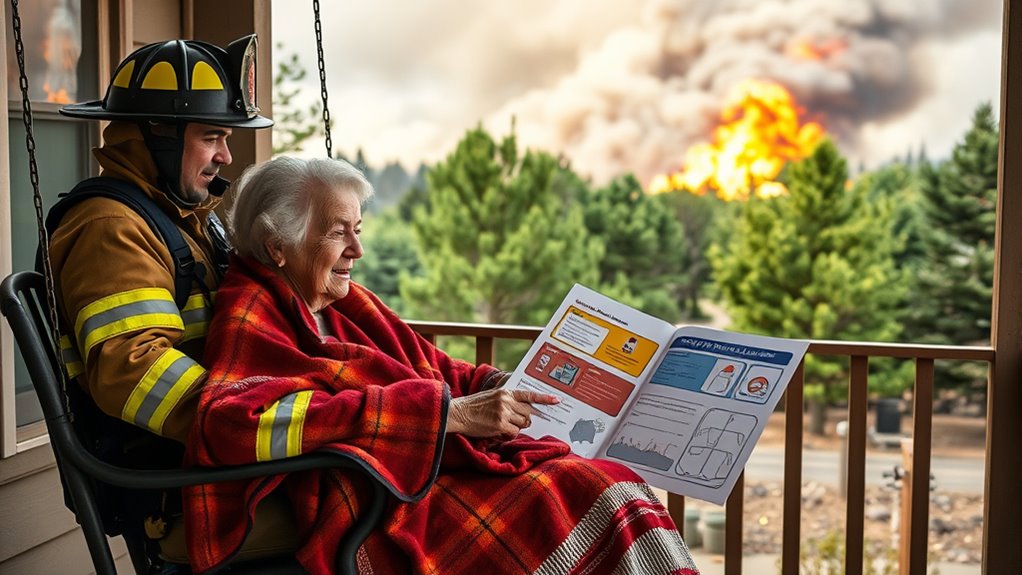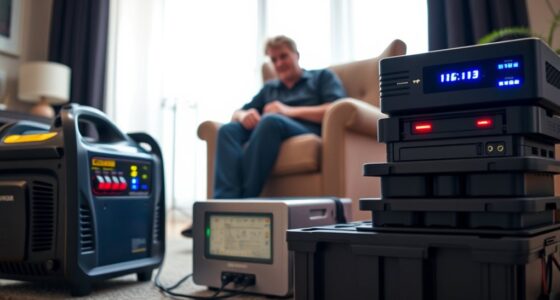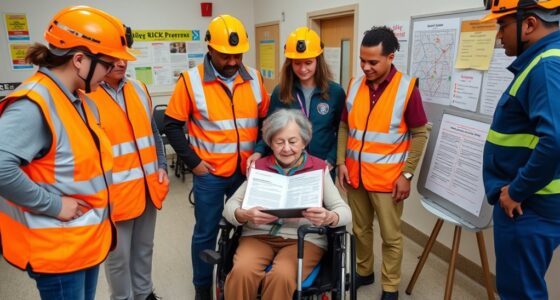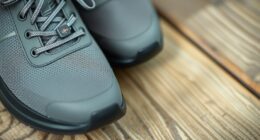To protect your elderly loved ones from wildfires, develop a detailed safety plan that includes clear evacuation routes suited to their mobility needs, and practice these routes regularly to ensure calm, quick responses. Prepare an emergency kit with essential medications, comfort items, and important documents, and update it often. Stay aware of their stress signals and safety considerations, and establish communication and meeting points. If you want to learn more about creating an effective wildfire safety plan, keep exploring the key steps involved.
Key Takeaways
- Develop a tailored evacuation plan considering elderly mobility and needs, and practice regularly for smooth execution.
- Identify support contacts and a safe meeting point to ensure coordinated evacuation and assistance.
- Prepare an emergency kit with medications, essential documents, and comfort items, and keep it easily accessible.
- Regularly update supplies, check batteries, and include medical records to meet changing needs.
- Recognize signs of stress in elderly loved ones and conduct drills to ensure calm, efficient evacuation.
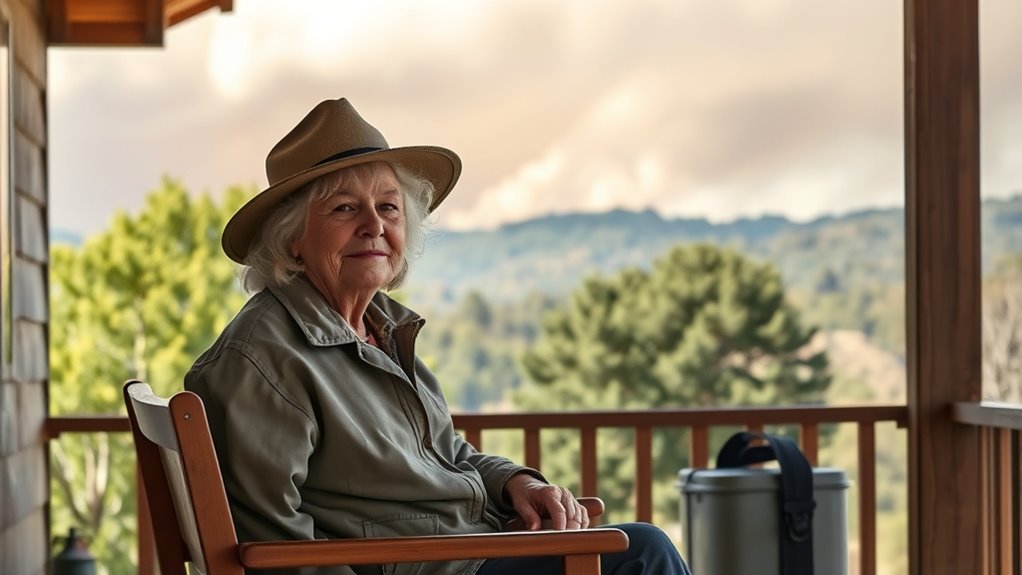
Creating a wildfire safety plan is vital to protect yourself, your family, and your property. When it comes to safeguarding elderly loved ones, having clear evacuation procedures and well-prepared emergency kits can make all the difference. Start by developing a detailed evacuation plan that considers their mobility and specific needs. Know your local evacuation routes and identify multiple options in case one becomes inaccessible. Practice these routes regularly so everyone knows what to do quickly and calmly when a wildfire threat arises. Make sure your elderly loved ones understand the plan and feel comfortable following it, especially under stress.
Develop a clear wildfire evacuation plan tailored to your elderly loved ones’ needs and practice it regularly.
Incorporate evacuation procedures that prioritize their safety. Consider whether they might need assistance or specialized transportation, and arrange for support if necessary. Keep a list of contacts, including neighbors, friends, or local emergency services, who can help during an evacuation. Always have a designated meeting point outside the danger zone, ensuring everyone knows where to gather. Preparing in advance helps reduce panic and confusion when time is critical. You might also want to develop a communication plan, like a phone tree, to keep everyone informed and coordinated. Staying informed about community alerts can help you respond more effectively during an emergency.
Emergency kit preparation is another essential aspect of your wildfire safety plan. Pack a kit that includes essentials tailored to your elderly loved ones’ needs. This should contain medications, glasses, hearing aids, and any mobility aids they might use. Include non-perishable food, bottled water, and hygiene supplies. Keep important documents—such as IDs, medical records, and insurance papers—in a waterproof container that’s easily accessible. Don’t forget comfort items like blankets or photos that can provide emotional support during stressful times. Having this kit ready and within reach ensures you’re prepared to evacuate at a moment’s notice. Remember that a well-organized emergency kit can significantly reduce evacuation time and stress.
Additionally, understanding the signs and symptoms of stress or confusion in elderly individuals can help you respond quickly during emergencies. Regularly review and update your emergency kit to account for changing needs or new medications. Ensure batteries are fresh in flashlights and that your communication devices are charged. Familiarize yourself with elderly-specific safety considerations to tailor your preparedness efforts effectively. Inform your elderly loved ones about the contents of the kit and where it is stored, so they feel confident in what to grab if needed. Practice packing the kit together during drills to streamline the process. Remember, the goal is to make evacuation as swift and stress-free as possible, especially for those who may need extra help or reassurance.
Frequently Asked Questions
How Often Should I Review Our Wildfire Safety Plan?
You should review your wildfire safety plan at least once a year to keep it current and effective. Conduct fire drills regularly, ideally every six months, to ensure everyone knows what to do. Also, update your safety plan after any significant changes, like new health needs or home modifications. Consistent reviews and drills help you stay prepared, giving your elderly loved ones the best protection during a wildfire.
What Special Considerations Are Needed for Elderly With Mobility Issues?
You should consider extra precautions for elderly with mobility issues during a wildfire. Make certain they have easy access to assistive devices and mobility aids at all times, especially in emergency situations. Create a clear evacuation plan that accounts for their mobility limitations, and practice it regularly. Keep necessary items, like medications and important documents, within reach. By planning ahead, you help keep your loved ones safe and reduce their stress during emergencies.
How Can I Ensure My Elderly Loved Ones Can Evacuate Quickly?
Think of evacuation as your loved ones’ escape plan from a roaring dragon. To guarantee they evacuate quickly, familiarize yourself with multiple evacuation routes, so they’re not trapped in a traffic jam. Keep mobility aids ready and close by, like loyal companions ready for action. Practice evacuation drills regularly, turning panic into muscle memory. With preparation, your loved ones can dash to safety like heroes in their own story.
What Types of Emergency Supplies Are Essential for Seniors?
You need to gather essential emergency supplies for seniors, including a well-stocked first aid kit and an updated emergency contact list. Make sure medications are readily available, along with water, non-perishable food, and necessary medical devices. Keep flashlights, batteries, and communication devices handy. By preparing these supplies, you help your elderly loved ones stay safe and recover quickly during emergencies, giving you peace of mind.
How Do I Communicate With Elderly Family Members During a Wildfire?
During a wildfire, you should prioritize clear communication with your elderly family members. Use technology assistance like cell phones or tablets to stay connected, and offer emotional support to ease their anxiety. Keep conversations simple, repeat important information, and be patient. Make sure they know you’re there for them, and check in regularly to verify they understand safety instructions and feel reassured during this stressful time.
Conclusion
By preparing ahead, staying informed, and practicing evacuation drills, you safeguard your elderly loved ones. By creating a clear plan, maintaining emergency supplies, and communicating regularly, you build confidence and resilience. By staying vigilant, acting swiftly, and supporting each other, you ensure everyone’s safety. Remember, a well-prepared wildfire safety plan isn’t just about protection — it’s about peace of mind, peace of mind that comes from readiness, reassurance, and unity during challenging times.
